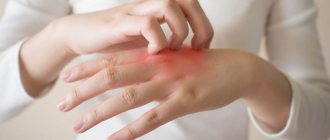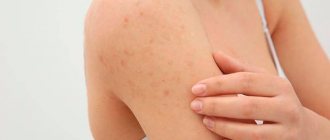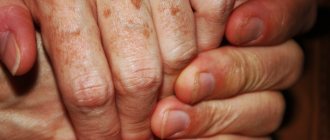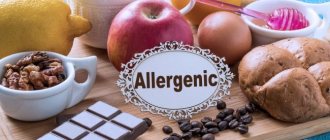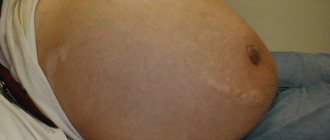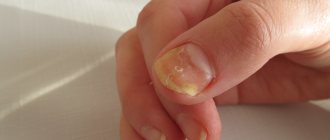Last update: 02/21/2021
Aquagenic urticaria is a rare, atypical reaction of the immune system that occurs in response to any human contact with water.
. It cannot be considered a disease in the usual sense of the word. No matter how unrealistic it may seem (after all, the human body is approximately 60% water), sometimes the immune system rejects it. It does not matter how exactly the liquid enters the body - be it through drinking, swimming in a pond, daily hygiene procedures, or even tears and sweat.
Let's figure out whether there could be an allergy to water (photos of its symptoms are given below), how it manifests itself and what can be done to treat this extremely unpleasant reaction of the body.
Allergy to water: symptoms
Manifestations of allergies to drinking water (mineral or tap water), as well as symptoms of allergies to sea water, swimming in a pool, shower or open water can vary greatly from person to person. Their symptoms of aquagenic urticaria depend on their overall health, resistance to irritants, age and immune system functioning. The following signs of an atypical reaction of the body in response to exposure to water can be identified:
- irritation on the skin (on the hands, for example);
- hyperemia and dry skin;
- peeling of the skin, the appearance of microcracks on it;
- severe itching;
- swelling;
- redness of the whites of the eyes, tearing, or vice versa – dry eyes, burning under the eyelids;
- headache;
- nausea, vomiting, gastrointestinal disorders.
Allergies and water spots on the skin
The appearance of red spots is the first and most common symptom of aquagenic urticaria. Sometimes all manifestations of allergies come down solely to it.
Stains appear after contact with water in any form. In appearance, they resemble nettle burns - extensive, slightly rising above the surface of the skin. It is precisely because of the similarity with the “bites” of nettles that this reaction of the body is called aquagenic urticaria.
Water rash
Sometimes the appearance of spots with aquagenic urticaria is not observed - the reaction is limited to a small rash that can cover large areas of the body without uniting into large spots. Usually the rash is accompanied by severe itching and burning, which causes discomfort to the person and even interferes with leading a normal life - doing everyday activities, going to work or school.
Allergy to sea water
An allergy to water on the face and other parts of the body that appears after swimming in the sea can occur for the following reasons:
- The composition of sea water is characterized by the presence of a number of salts and minerals, which can cause allergies.
- At certain periods algae blooms, which enrich the sea with certain organic substances.
- The presence of industrial waste in the water cannot be ruled out (especially if you swim near ports).
- Many microorganisms live in sea water, the waste products of which can cause an allergic reaction.
To avoid undesirable consequences after swimming in the sea, you need to determine which of these factors caused the atypical response of the immune system. It is quite possible that if you swim at another resort, undesirable consequences can be avoided.
Allergy to tap water
The appearance of allergy symptoms to tap water is usually due to the presence of impurities in its composition - primarily chlorine, which is used to disinfect it. Symptoms of an allergy from tap water are usually not much different from the reactions described above.
You can avoid manifestations of an atypical response of the immune system to the contents of water pipes by minimizing contact of water with the skin or installing a high-quality filter (for example, a reverse osmosis system). You can also use it only in boiled form - in this state, the effect of chlorine on the skin can be minimized.
In many cities there are so-called pump rooms - structures built above the outlet of water from the ground. Moreover, we are talking not only about resort areas where there are mineral waters - a pump room can also be installed above an artesian well, that is, in almost any city.
Sometimes the appearance of rashes, dryness and other symptoms of an atypical skin reaction to water is not caused by the composition of the water, but by the means used to wash your hands, head, and body. Therefore, it is recommended to abandon the usual scented shower gels, soaps and lotions and use more gentle and delicate products - for example, La Cree emulsion, shampoos and rinses.
What can happen if you refuse to wash your face?
The paradox is that for those with problem skin, both refusal to wash and frequent hygiene procedures are harmful. In the first case, there is a risk of clogging the pores with cosmetic residues. This is especially dangerous if it is comedogenic, that is, it can provoke the appearance of acne.
But frequent washing (more than 2 times a day) is not beneficial for the skin, since it destroys the natural protective barrier of the epidermis. Cosmetologists recommend looking for a compromise:
- use non-comedogenic cosmetics;
- be sure to remove makeup before going to bed;
- wash your face no more than 2 times a day (morning and evening) with purified water;
- use toner and moisturizer after washing.
“La-Cri” products to improve the condition of skin with allergies from water
Since dryness is one of the most common symptoms of water allergy on the hands (as well as on other parts of the body), it is important to ensure adequate nutrition and hydration of the skin. To do this, it is recommended to use La-Cri intensive cream for dry skin. Shea butter, jojoba and wheat germ, natural extracts of licorice, chamomile and violet, as well as allantoin and lecithin ensure a rapid restoration of the protective properties of the skin, which leads to the elimination of dryness, rashes and redness. However, we must not forget that the treatment of aquagenic urticaria cannot be carried out only with cosmetics - they can only complement the main therapy, but not replace it completely.
How to care for skin without water?
When it comes to cleansing the skin without water, the following scheme is usually proposed:
- Cleansing. You need to remove makeup using milk.
- Toning. Using a tonic requires you to get rid of any remnants of your cleanser.
- Hydration. The final touch is applying a moisturizing or nourishing cream.
This scheme is not approved by all cosmetologists and dermatologists, but it is acceptable for those with dry and sensitive skin. After washing with regular running water, they may experience dryness, flaking, and redness of the skin.
But even in this case, there is an alternative to “dry” washing - the use of purified water, for example, filtered or store-bought drinking water. You don’t even have to wash your face, but wipe your face with a sponge dipped in water. This will help to better cleanse the skin of cosmetic residues.
Refusal to wash your face is contraindicated for those with combination, oily and problem skin. They should also stop using cleansing milk and switch to foam or gel.
Experts' opinion
The conducted clinical study proves the high efficiency, safety and tolerability of products for daily skin care of children with mild and moderate forms of atopic dermatitis and during remission, accompanied by a decrease in the quality of life of patients. As a result of therapy, a decrease in the activity of the inflammatory process, a decrease in dryness, itching and flaking was noted.
It has been proven that La Cree cream for dry skin:
- eliminates dryness and flaking;
- retains the skin's own moisture;
- protects skin from wind and cold.
Sources:
- I.A. Gorlanov, L.M. Leina, I.R. Milyavskaya, Skin of newborns: differential diagnosis of pathological conditions, features of care https://cyberleninka.ru/article/v/kozha-novorozhdennyh-differentsialnaya-diagnostika-patologicheskih-sostoyaniy-osobennosti-uhoda
- N.D. Odinaeva, G.V. Yatsyk, I.A. Belyaeva Correction of dry skin in newborns, Pediatrics journal, 2011 https://cyberleninka.ru/article/v/korrektsiya-suhosti-kozhi-u-novorozhdennyh-detey
- B.A. Shamov, I.G. Safiullina, A.B. Beshimova, T.B. Shamov, Differential diagnosis of atopic dermatitis, journal of Practical Medicine, 2011 https://cyberleninka.ru/article/v/differentsialnaya-diagnostika-atopicheskogo-dermatita
- Fokina R.A., Atopic dermatitis: stages of development of classification forms, Siberian Medical Journal, 2007 https://cyberleninka.ru/article/v/atopicheskiy-dermatit-etapy-razvitiya-klassifikatsionnyh-form
Myths and facts about acne
There is as much useful information about acne as there is bad advice and myths: from old wives' tales to practical advice from friends and home remedies based on recipes from the Internet. However, with such skin problems, it is better to consult a dermatologist or cosmetologist.
Therefore, before treating acne, it is better to separate the facts from the myths. In this article we will look at the most common myths about acne.
Myth 1. Eating too much chocolate will cause acne.
There are several opinions regarding this thesis. Jennifer Burris, author of the Academy of Nutrition's review on diet and acne, studied the diets of more than 200 people and found that those who ate more sugary foods, dairy products, fast-digesting carbohydrates and fats, but less fish, were more likely to have moderate to severe acne. degree of acne.
While there is a link between diet and acne, it is unfair to blame chocolate alone for your new acne. Almost any food with a high glycemic index - sweets, bread, pasta - can increase the level of cortisol in the blood and worsen acne. Such products are also called “refined carbohydrates”. They cause insulin levels to spike, which leads to increased sebum production and clogged pores.
Fact
The problem is not the cocoa beans themselves, from which chocolate is made, but the added sugar and dairy products. The higher the percentage of cocoa, the lower the glycemic index, which means the fewer provoking factors for the sebaceous gland.
Myth 2. Acne is a teenage problem.
In fact, a survey of more than 1,000 adults found that 50% of women aged 20 to 29, 35% of women aged 30 to 39, and 26% of women aged 40 to 49 have acne. It has been proven that estrogen levels increase during the first menstruation and premenopause, thereby provoking an exacerbation of skin problems.
Fact
When acne appears in adolescence, it is very important to properly cleanse and use products that exfoliate epidermal cells and normalize the secretion of sebum. Such products should be light in texture and effect on the skin.
When caring for skin with signs of “mature acne”, care products based on acids and retinoids are recommended. Skin cleansing should be done more carefully and always with the use of sunscreen products, as well as drugs that will strengthen the contours of the face.
Myth 3: Makeup products can make acne worse.
It's true that makeup products can clog your pores and ultimately cause acne. However, the right makeup can really improve your acne situation. Mineral bases with ingredients such as silica, titanium dioxide and zinc oxide are anti-inflammatory.
Fact
The main thing is to use makeup correctly and choose products that do not clog pores. What phrases should you pay attention to on makeup product packaging:
- Doesn't clog pores.
- Low-fat, or oil-free.
- Non-comedogenic.
- Hypoallergenic.
- Does not contain mineral oils, or mineral oil-free.
If you use brushes or sponges, be sure to wash them with your regular cleanser and dry thoroughly after each use. For acne-prone skin, pay attention to drugstore brand foundations and mineral cosmetics.
Myth 4. The higher the concentration of active ingredients in an “acne remedy,” the more effective it is.
If you've spent more than 30 seconds studying the label of an acne product, then you probably already know: benzoyl peroxide and salicylic acid are the leading acne products. There are two main purposes of acne products: to unclog pores and eliminate bacteria. These ingredients are often recommended because benzoyl peroxide kills bacteria and salicylic acid has a keratolytic effect, thereby unclogging pores. There is no need to use products that are high in these ingredients, especially when it comes to benzoyl peroxide. A review published in the journal Expert Opinion Pharmacotherapy found no difference in effectiveness between products containing 2.5% benzoyl peroxide and those containing 10%.
Fact
Today, almost all stages of acne can be kept under control, some can be put into remission and the skin can be supported with home care products. If you do not see results from self-medication, be sure to consult a dermatologist. It will help make your skin clear and healthy.
Myth 5. Toothpaste can cure acne
Toothpaste contains baking soda, hydrogen peroxide, alcohol, menthol, essential oils and triclosan, which can dry out acne but not get rid of it. Toothpaste is not designed to be applied to the face or body, as this may cause irritation and rashes. Using toothpaste to correct acne, you can aggravate the situation: the acne will remain in place, and irritation and dryness will be added.
Fact
Instead of self-medicating with improvised means, try using local remedies that contain salicylic acid and benzoyl peroxide.
Myth 6. The sun will help cure acne
Here's the thing: exposure to sunlight masks inflammation in the skin, and since acne is an inflammatory process, you may see a reduction in inflammatory elements due to the anti-inflammatory effects of UV. But this effect is minimal, and, most likely, under the influence of sunlight, the skin will become more sensitive, dry, and therefore will produce more sebum. UV will create favorable conditions for the life of bacteria and provoke the appearance of new acne elements.
Fact
Over time, the sun breaks down collagen, which is part of the dermis, the second layer of skin. Collagen is a protein that keeps the skin elastic, tight and young. When collagen breaks down, the pores have less support and they sag and deepen. This triggers acne, some of which can stay with you for life. In addition, excessive sun exposure makes it difficult for the skin to recover and increases the risk of acne scars, the so-called post-acne phenomenon.
Myth 7. The appearance of new acne on the skin means that you are not washing your face enough.
When you wash your face too often, you strip your skin of its natural oils. This makes the skin dehydrated and sensitive, which it compensates for by producing even more sebum. It clogs the pores and makes the flare-up more pronounced.
Fact
In the morning you can use a light cleanser - foam or cream gel, but in the evening you need to make your evening wash better and use a gel with salicylic acid. When choosing a cleanser, avoid those that contain exfoliating beads or sodium lauryl sulfate, which cause additional skin irritation. After washing your face, apply a cream with retinol or azelaic acid. Here are some tips for quality skin care for acne:
- Gently wash your face twice a day with a mild, unscented cleanser.
- Gently apply cleanser with your fingertips.
- Rinse off the detergent with warm, but not hot, water.
- Do not use scrubs and ultrasonic brushes for home use on a daily basis.
- Choose a cleanser based on your skin type.
Myth 8. Moisturizer clogs pores.
It may seem counterintuitive to apply moisturizer to oily skin, but the reality is different. Very often, oily skin shows signs of dehydration, and this produces more sebum, which clogs the pores - this is called a compensatory mechanism.
Fact
If instead of a heavy cream you apply a light moisturizer or fluid every day, your skin will not need to take hydration into its own hands and produce more sebum.
Myth 9: Going to a chlorinated pool every day will help get rid of acne.
It may seem that while swimming, the skin looks better and acne is less pronounced, but this is the same story as using toothpaste. Chlorine, when applied to the skin, has a local drying effect on acne, but it can also irritate the skin, causing exacerbations and the appearance of new acne elements.
Fact
After visiting the pool, be sure to take a shower and wash your face using an oil-free lotion to compensate for any signs of dryness and tightness of the skin.
Myth 10. If you squeeze a pimple, it will go away faster
Very misleading and contradictory advice. You will remove the part of the element that is visible to the eye, but at this time you will damage the capsule of the pilosebaceous follicle. As a result of this, the secretion contained inside will be released into the surrounding tissue and further cause the spread of infection and inflammation. Therefore, use a topical salicylic acid-based product at night.
Fact
Applying an ice cube to the pimple will help temporarily reduce inflammation. Then use a targeted benzoyl peroxide to kill the bacteria, or a salicylic acid serum to loosen the bonds between the dead cells and speed up their sloughing, otherwise they will become a breeding ground for bacteria. Using a small amount of concealer will help hide the pimple. Just make sure that the product is non-comedogenic and does not contain a lot of silicones that clog pores.
Myth 11. Stress does not affect the number of acne on the face
A pimple that appeared on the most important day of your life wasn't just an unfortunate coincidence. Any stressful or exciting situation creates a hormonal imbalance in the body, which can lead to acne.
Myth 12. Pimples appear overnight.
It seems to us that acne always appears suddenly. In fact, a certain series of sequential events must take place before the inflammatory element becomes noticeable on the face. Acne is a complex process, and for a pimple to appear, four sequential steps must occur:
- There should be an excess of dead skin cells on the skin that clog the pores.
- A large amount of sebum is released.
- Excessive growth of bacteria p. acnes in pores.
- Inflammation of the skin is a reaction to the activity of bacteria.
Fact
It's important to treat acne before it starts to appear. Azelaic acid-based products that act on microcomedones can help with this. Although it may take some time in the beginning, a consistent, daily acne treatment routine will break the vicious cycle of acne formation.
Myth 13. Pores on the skin can open and close.
You've probably heard that you can steam your pores with hot water and close them with cold water, but this is not true. Pores are the excretory ducts of sebaceous and hair follicles. The main functions of pores are excretory, thermoregulatory and restoration of acid-base balance. Pores do not have muscles that open and close them.
Fact
Pore size is mainly determined by genetics. However, enlarged pores filled with oxidized secretions appear larger than clean pores. The most important thing you can do to tighten pores is to properly cleanse your skin every day, as well as use topical acid-based products in the form of masks and peels.
Myth 14. Dirty skin causes acne.
The good news is that dirt does not cause acne. The bad news: the bacteria that causes acne (p. acnes) are already on your skin and “feed” on secretions, sebum. Washing your face twice a day will help reduce bacterial colonization, normalize oil production, and help exfoliate dead skin cells.
Fact
Dirt does not cause acne. You see acne when the pores are clogged with excess sebaceous secretions oxidized under the influence of oxygen - sebum, as well as exfoliated skin cells. This whole background has a very beneficial effect on the bacteria that cause acne. The dark color of blackheads is a chemical reaction that occurs when air mixes with something that clogs the pores, similar to how a cut apple turns brown.
Using products with acids, as well as retinoids, will help cleanse pores and normalize the quality of sebum. But remember: products with retinoids and acids are not recommended for use in summer. They are more suitable for autumn and winter. And even in this case, such products should be used in the evening, and sunscreen and fluids should be applied in the morning to avoid unwanted pigmentation.
Myth 15. All exfoliators are the same
All scrubs contain abrasive particles visible to the eye, which mechanically act on the skin and remove dead cells. Other exfoliators contain glycolic and salicylic acid, as well as enzymes from papaya and pineapple, which chemically “dissolve” dead cells and thereby remove them from the surface of the skin.
Myth 16. If you drink more water, acne will go away.
Another diet myth is that drinking more water will somehow “wash away” your pimples from the inside out. There is no scientific evidence that drinking plenty of water will reduce acne.
Fact
Each person should drink a certain amount of water per day - the average is eight glasses. And any liquid such as juices, tea and coffee is not included in this norm; the body requires clean drinking water.

